How to Deal with Weeds in Your Lawn – Top Weed Control Tips
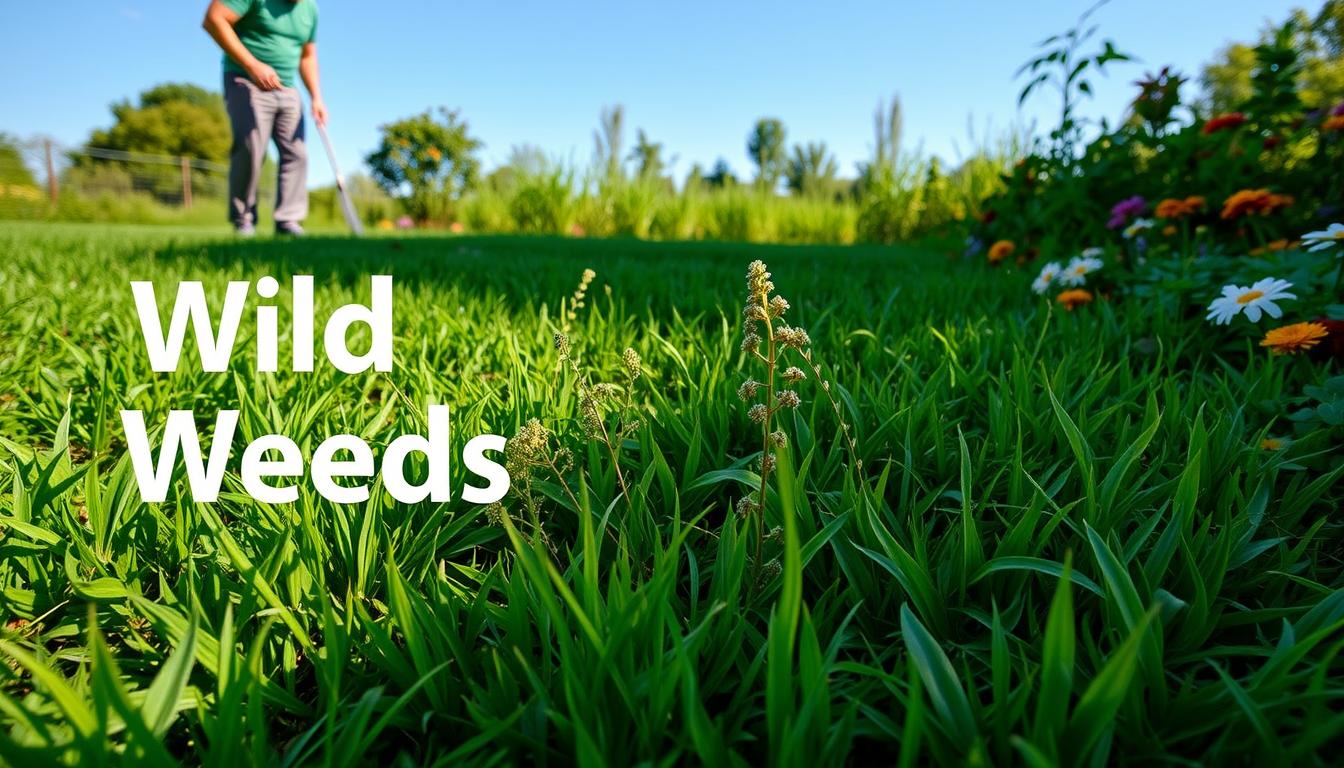
Did you know that every square inch of your garden has weed seeds?
But only those in the top inch or two get enough light to grow. Weeds can be a big problem in lawns. But, with the right strategies, you can keep them under control and have a healthy, vibrant outdoor space. In this article, I’ll share my top weed control tips, organic weed control methods, and ways to stop weeds from coming back.
In this article, I’ll share some easy-to-follow weed control tips that can keep your lawn healthy and vibrant. If you’re wondering how to deal with weeds in your lawn, it all starts with identifying the types of weeds you’re dealing with.
Key Takeaways
- Weeds can spread through various means, including wind, water, animals, soil amendments, and lawn equipment.
- Identifying the type of weeds in your lawn (broadleaf, grassy, or grass-like) is the first step in developing an effective control strategy.
- Promoting a healthy lawn through proper mowing, watering, and fertilization can discourage weed growth.
- Manual removal, such as hand-pulling or using weeding tools, can be an effective organic weed control method.
- Mulching and using landscape fabric can help prevent weed seeds from germinating and taking hold in your lawn.
Identifying Common Lawn Weeds
If you’re struggling with weeds, these weed control tips will help you take back your lawn. When you know how to deal with weeds effectively, you’ll spend less time pulling them and more time enjoying your lawn.
Weeds can be a big problem for homeowners who want a green lawn. Knowing the different weeds and their looks is key to fighting them. Let’s look at the main types: broadleaf weeds, grassy weeds, and grass-like ones.
Broadleaf Weeds
Broadleaf weeds, like dandelions and clover, have wide leaves. They look different from grass. These weeds grow in the spring and fall, when lawns are not healthy.
Grassy Weeds
Grassy weeds, such as crabgrass and foxtail, look like your lawn’s grass. They’re hard to spot and control. Crabgrass grows in the spring and summer, in thin spots.
Grass-like Weeds
Grass-like weeds, like wild onions and nut sedge, have a hollow shape. They grow in moist, shady spots and bare areas.
Knowing which weeds you have is the first step to controlling them. Weed seeds can wait years for the right time to grow. By understanding weeds, you can keep your lawn healthy and weed-free.
| Weed Type | Characteristics | Growth Patterns | Preferred Conditions |
|---|---|---|---|
| Broadleaf Weeds | Wide, flat leaves | Emerge in spring and fall | Thin or unhealthy lawns |
| Grassy Weeds | Resemble grass in appearance | Germinate in spring, visible in summer | Thin or bare areas, dry soil |
| Grass-like Weeds | Tubular, hollow shape | Thrive in warm, moist conditions | Moist, shady areas, bare spots |
Promoting a Healthy Lawn to Discourage Weeds
Keeping your lawn healthy is the best way to fight weeds. By following key lawn care steps, you can make your lawn less welcoming to weeds. This lets your grass grow strong and healthy. Here are some tips to help your lawn stay weed-free.
Proper Mowing Height and Frequency
Knowing the right techniques for how to deal with weeds can make your lawn look better and reduce the need for harsh chemicals.
It’s important to mow your grass at the right height. The best height is between 2.5 and 3.5 inches, depending on your grass type. Fairway Lawns suggests keeping your mower at this height to keep your lawn strong.
Mowing too short can weaken your grass. This makes it easier for weeds to take over.
Adequate Watering and Fertilization
Learning how to deal with weeds naturally can be as simple as adjusting your watering and mowing habits.
Watering and fertilizing your lawn correctly is key.
Lawns need about 1 to 1.5 inches of water each week.
This can come from rain or a sprinkler system. Fairway Lawns recommends a regular watering schedule to help your grass grow deep roots.
Also, regular fertilization gives your grass the nutrients it needs. This helps it grow strong and fight off weeds.
Addressing Soil Compaction and Drainage Issues
Soil health is crucial for a healthy lawn. Compacted or poorly draining soil can lead to weed growth. Fixing these problems, like aerating the soil, makes your lawn more resistant to weeds.
By following these lawn care tips, you can create a lawn that fights weeds and grows well. For more advice on keeping your lawn weed-free, talk to the experts at Fairway Lawns.
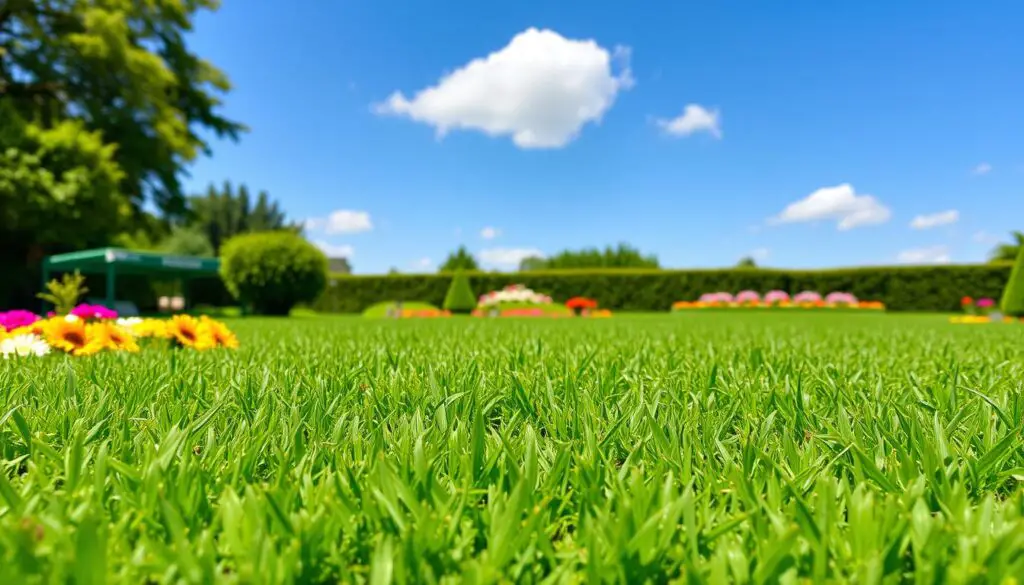
Weed Control Tips: Manual Removal
Manual removal is a great way to control weeds in your lawn. It’s good for the environment and gets rid of weeds for good. By pulling weeds by hand, you can get rid of them at the root and stop them from coming back.
Hand Pulling and Digging Up Weeds
Hand pulling is a simple way to remove weeds. It works best when the soil is moist. This makes it easier to pull out the weed and its roots. For bigger weeds, a dandelion digger can help you get them out completely.
Using Weeding Tools
There are also tools that can help with weed control. Hoes and cultivators can cut off weeds at the surface. They’re great for getting rid of lots of weeds or those in hard-to-reach spots.
- Hoes: Helpful for slicing through and removing shallow-rooted weeds
- Cultivators: Excellent for loosening soil and dislodging deeper-rooted weeds
It’s important to act fast when removing weeds. This way, they can’t spread and make more weeds. Weeding a little bit each week can keep your lawn weed-free.
“The most sustainable way to control weeds is to address the root causes, not just the symptoms. Manual removal is a valuable tool in an integrated approach to weed management.”
Using Herbicides for Weed Control
Herbicides can be a strong ally in fighting weeds in your lawn. They come in two types: pre-emergent and post-emergent. Knowing the difference is key to managing weeds well.
Pre-Emergent Herbicides
Pre-emergent herbicides stop weeds from growing by creating a barrier. They work best on annual weeds like crabgrass and foxtail. Apply them 1-2 weeks before weeds start growing in your area.
Post-Emergent Herbicides
Post-emergent herbicides kill weeds that are already growing. They work by stopping the weeds’ internal processes, causing them to die. These herbicides can tackle many weed types, including dandelions and clover.
Selective vs. Non-Selective Herbicides
Herbicides can be selective or non-selective. Selective ones target specific weeds without harming grass. Non-selective ones kill any plant they touch, so use them with care.
Using herbicides correctly is important for safety and effectiveness. Always follow the label and talk to your local County Extension Service for advice on the right herbicides for your lawn.
“Herbicides can be a valuable tool in the fight against weeds, but they must be used responsibly and in conjunction with other lawn care practices for long-term success.” – Richard, ecology specialist
Natural and Organic Weed Control Methods
Want a weed-free lawn? Check out these effective weed control tips that work naturally.
As a passionate gardener, I know how important it is to keep your lawn and garden weed-free. But, we don’t need to use harsh chemicals to do it. There are many natural weed control and organic herbicide options that are better for the environment.
Corn gluten is a great natural choice. It’s a byproduct of corn milling and stops weed seedlings from growing. It’s perfect for keeping weeds like crabgrass away. Another option is acetic acid, or vinegar, which can kill weeds that are already growing.
- Flame weeders are fun and effective for controlling weeds in specific spots like fence rows or driveways.
- Homemade solutions like boiling water or dish soap can work too. But, be careful not to harm other plants or the soil.
These natural methods might not be as strong as chemical weed killers. But, they can work well if used right, and they’re safer for the environment.
“Proper timing and application are key when using natural and organic weed control methods. Be patient and persistent, and you’ll be rewarded with a healthy, vibrant lawn and garden.” – Laura, organic and bio lawn care enthusiast
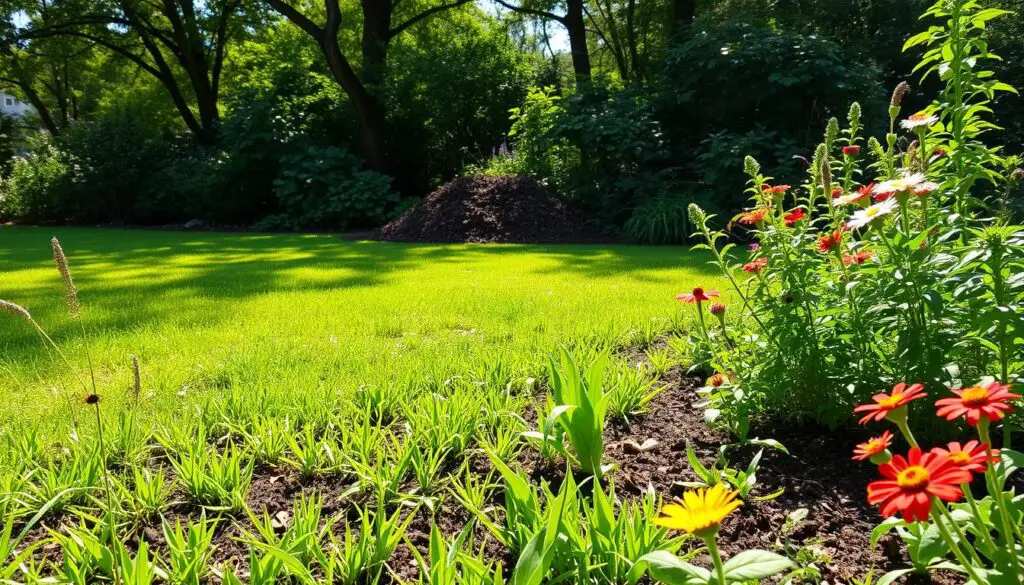
By using these eco-friendly weed management techniques, you can have a beautiful outdoor space without harming the planet. It’s a win-win!
Weed control tips: Mulching and Landscape Fabric
For those battling persistent weeds, these simple weed control tips can make a big difference.
Keeping your garden weed-free is a challenge. But, using mulching for weed suppression and landscape fabric or weed barrier can help. These methods work together to stop weeds from growing.
Putting down a thick layer of organic mulch around plants stops weeds. Good mulch choices are shredded bark, wood chips, or leaves. Aim for 2-4 inches thick, and refresh it every 4-5 years for best results.
Adding landscape fabric or weed barrier to mulch makes a strong weed-fighting team. Landscape fabric is a strong, breathable material that keeps sunlight out and weeds from growing. It’s great for beds, around trees, and other non-grassy areas.
But, landscape fabric has its downsides. It can get clogged with organic matter and weed seeds over time. Also, some roots might break through, needing regular upkeep. Synthetic barriers can harm soil life and disrupt soil health.
For a greener option, try using cardboard as a weed barrier. Layered with mulch, it kills weeds and breaks down in 6 months to a year. This lets the soil and plants grow healthily.
Using mulch, landscape fabric, and other weed control methods can make your garden beautiful and easy to care for. Knowing the good and bad of each method helps gardeners find the best mix for their garden.
Preventing Future Weed Growth
With the right weed control tips, you can reduce the need for harsh chemicals and keep your garden thriving. To keep weeds away, it’s key to take preventative steps.
Overseeding thickens the grass, making it harder for weeds to grow. Aerating the soil lets water, air, and nutrients reach the roots, helping grass grow strong.
Good lawn care practices also help. Mowing at the right height, watering deeply but less often, and using the right fertilizer all help keep weeds away.
Overseeding and Aerating Lawns
Overseeding your lawn is a smart way to stop weeds. It makes the turf denser and healthier, making it harder for weeds to take over. Aerating the soil improves how well water, air, and nutrients reach the roots, helping grass grow strong.
Maintaining Proper Lawn Care Practices
Good lawn care is essential to keep weeds out. Mowing at 3-4 inches shades the soil and encourages deep roots. Watering deeply but less often helps roots grow deep and makes the lawn more drought-resistant.
Regular fertilization with a balanced, slow-release formula gives your grass the nutrients it needs to fight off weeds.
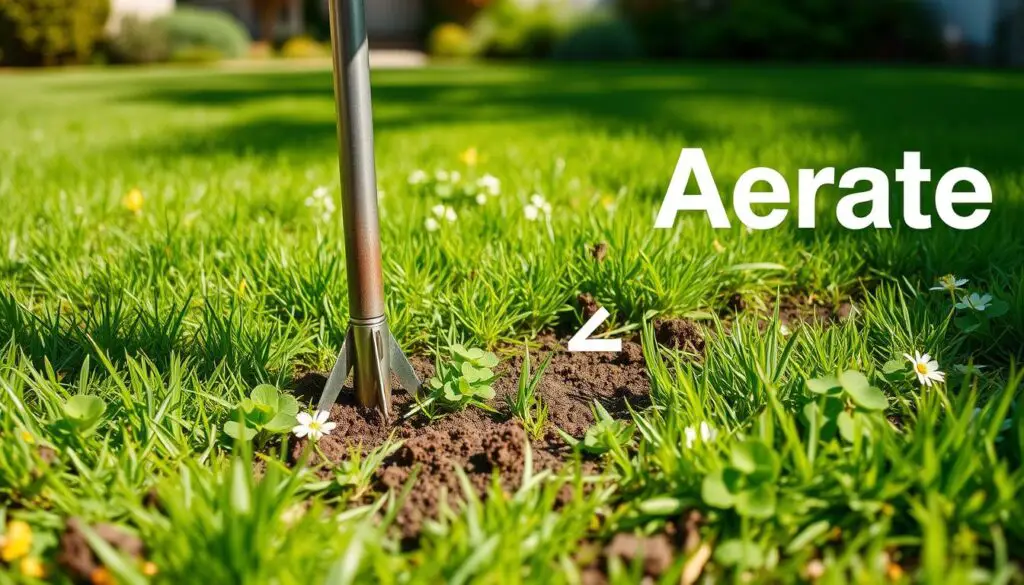
By focusing on these steps, you can keep your lawn healthy and vibrant. A well-cared-for lawn is the best way to fight off weeds.
Integrated Pest Management Approach
For effective and sustainable weed control, an integrated pest management (IPM) approach is key. It uses many tactics like manual removal and natural methods. It also includes targeted herbicide use and cultural practices to prevent weeds.
This method looks at the whole lawn and garden ecosystem. It addresses the root causes of weed problems, not just the symptoms.
The key elements of an IPM program include:
- Maintaining a healthy, balanced ecosystem to discourage weed growth
- Regularly monitoring for weed infestations and identifying the specific weeds
- Considering all control options before taking action, prioritizing the most eco-friendly methods
- Employing site-specific strategies to enhance crop health and stability
Integrated pest management is not a one-size-fits-all solution. It tailors control methods to your lawn or garden’s specific needs. This reduces reliance on harmful pesticides and promotes sustainable weed control.
By combining multiple weed control strategies, you can manage weeds effectively. This protects the environment and keeps your landscape healthy.
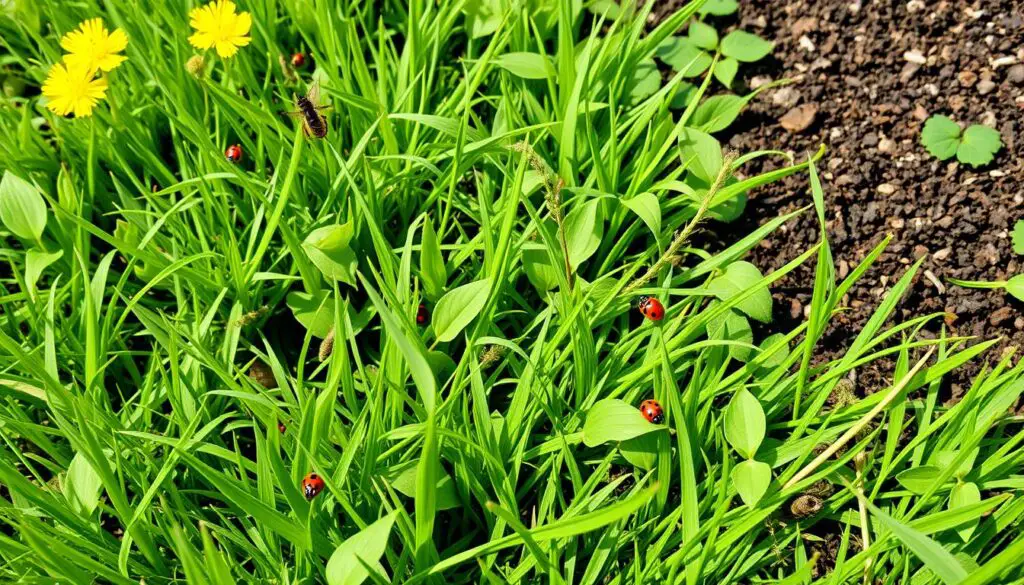
“Healthy plants are more resistant to pests; soil preparation is crucial in preventing plant stress and pest infestation.” – Sam, author of The Mowers Guide
An integrated pest management approach aims for balance and variety. It uses many techniques to create a thriving, weed-free lawn or garden. By being proactive and comprehensive, you can manage weeds effectively and responsibly.
Seasonal Weed Control Schedule and Herbicides
Weed control is a year-round task.
In early spring, I use pre-emergent herbicides like Scotts® Turf Builder® Triple Action. This stops weeds like crabgrass before they grow. When weeds show up in spring and summer, I pull them by hand or use Scotts® Liquid Turf Builder® with Plus 2 Weed Control.
In fall, I overseed my lawn and aerate the soil to prevent weeds. Scotts® Turf Builder® WinterGuard® Fall Lawn Food feeds the lawn. Scotts® Turf Builder® Summerguard® helps it grow in summer. Keeping up with weed control is crucial for a healthy lawn.
Managing weeds involves pre-emergent herbicides in spring, hand-pulling in season, and overseeding in fall. Using Scotts® products at the right times keeps my lawn looking great all year.
FAQ
What are the main types of weeds that can grow in my lawn and garden?
How can I promote a healthy lawn to prevent weed growth?
What are some effective manual weed removal techniques?
When should I use herbicides for weed control?
Are there any natural or organic weed control methods I can use?
How can mulching and landscape fabric help with weed control?
What can I do to prevent future weed growth in my lawn and garden?
How can I take an integrated approach to weed control?
When should I tackle different weed control tasks throughout the year?
Source Links
- https://www.finegardening.com/project-guides/gardening-basics/six-tips-for-effective-weed-control
- https://scotts.com/en-us/lawn-care-101/guide-to-7-common-lawn-weeds.html
- https://www.architecturaldigest.com/reviews/lawn/identifying-and-controlling-lawn-weeds
- https://extension.umn.edu/lawn-care/lawn-weeds
- https://fairwaylawns.com/blog/lawn-care/effective-weed-control-through-regular-lawn-care
- https://www.lawnstarter.com/blog/lawn-care-2/guide-weed-control-yard/
- https://www.yourgreenpal.com/blog/kill-weeds-in-an-eco-friendly-way
- http://npic.orst.edu/pest/weeds.html
- https://extension.okstate.edu/fact-sheets/guide-to-effective-weed-control.html
- https://hgic.clemson.edu/factsheet/weed-control-in-landscapes-herbicides/
- https://www.heirloomsoul.com/blog/how-to-suppress-weeds-organically-without-chemicals
- https://www.thespruce.com/weed-control-without-chemicals-2132928
- https://savvygardening.com/organic-weed-control-tips/
- https://albopepper.com/landscape-fabric-vs-sheet-mulching.php
- https://www.heirloomsoul.com/blog/the-best-landscape-fabric-for-killing-weeds
- https://www.gooseberrygardens.ca/post/weeds-the-evils-of-landscape-fabric
- https://www.homedepot.com/c/ai/how-to-prevent-weeds/9ba683603be9fa5395fab90a6e6a869
- https://virginiagreen.com/news/how-to-prevent-weeds-from-growing-in-your-mulch-bed
- https://content.ces.ncsu.edu/extension-gardener-handbook/8-integrated-pest-management-ipm
- https://www.topcropmanager.com/going-back-to-basics-with-ipm-19556/
- https://scotts.com/en-us/lawn-care-101/your-seasonal-guide-to-a-lush-lawn.html
- https://hgic.clemson.edu/factsheet/managing-weeds-in-warm-season-lawns/

